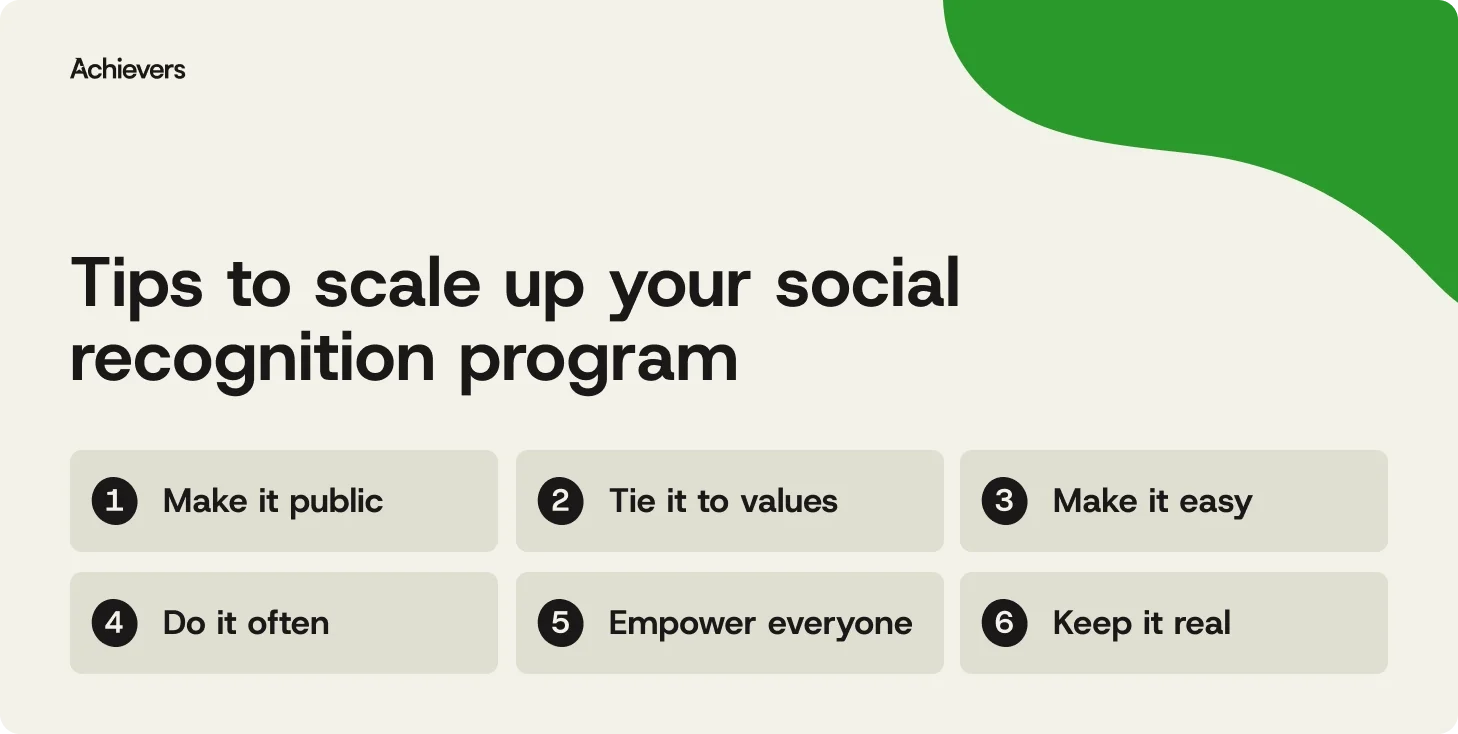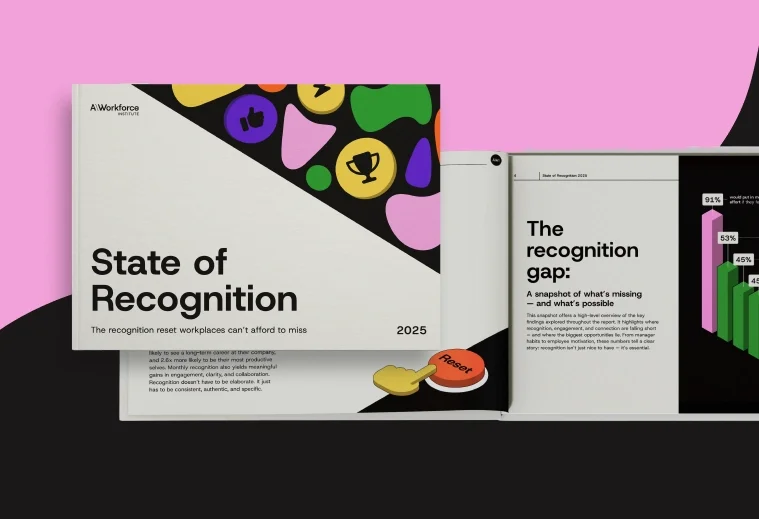Table of contents
Create a culture that means business™
Schedule a demo with an Achievers solution expert today.
Let’s skip the buzzwords. You don’t build culture with kombucha taps and casual Fridays — you build it by making people feel seen, valued, and connected to something bigger than their to-do list. That’s exactly what social recognition does.
When recognition is timely, meaningful, and tied to your company values, it becomes more than a morale booster. It becomes a lever for real behavioral change — the kind that drives engagement, retention, and bottom-line results.
So yes, a simple “thank you” goes a long way. But when it’s done right and done often, it does more than make someone’s day. It shapes the kind of culture where people want to show up, contribute, and stay.
And that’s a strategy worth paying attention to.
What is social recognition — and why should you care?
Think of it as the everyday magic that happens when people are seen for doing great work — loudly, clearly, and often.
Social recognition is peer-to-peer recognition and manager-to-employee acknowledgment that’s public, purposeful, and tied to your company values. It’s not a once-a-quarter “nice job” buried in an email — it’s frequent, visible, and embedded in the flow of work.
Why does it matter? Because when people feel appreciated, they engage more, align faster, and stick around longer. It’s the kind of motivation that doesn’t just lift performance — it builds culture.
You could call it an espresso shot for your workforce: quick to deliver, strong enough to keep things moving, and best served daily. And unlike actual espresso, it doesn’t require a budget line — or a backup machine.
The ripple effect: How one “thank you” can shift your whole culture
Recognition may start with one person — but it rarely ends there.
When someone’s acknowledged for living your values, it sends a signal to everyone else: This is what matters here. Over time, those individual moments start to add up. Patterns emerge. Expectations align. And just like that, you’re not just rewarding behavior — you’re shaping it.
This is how culture gets built — not through lofty mission statements, but through consistent action. Social recognition turns company values from words on a wall into everyday habits your team can see, feel, and rally around.
So no, it’s not about dishing out gold stars. It’s about reinforcing what great looks like — again and again — until it becomes second nature. And maybe a few gold stars too. They’re oddly motivating.
The ROI of being human
Appreciation isn’t just good manners — it’s good business.
Frequent, meaningful recognition leads to higher engagement, better performance, and lower turnover. And that’s not just a nice theory — it’s backed by real data. Organizations that use Achievers recognize twice as often as those using other platforms, and often see up to 5x the engagement as a result.
When employees feel valued, they’re more motivated to do their best work, more likely to stay, and more invested in your company’s success. It’s a ripple effect with real numbers behind it — not just a warm-and-fuzzy feeling.
So yes, saying “thank you” might seem small. But when it’s backed by science, tied to values, and shared widely, it becomes one of the most cost-effective ways to drive business results. Turns out, being human at work pays off — literally.
The science behind the sparkle
Recognition might feel like a small gesture — but its impact is anything but.
Backed by behavioral psychology and research from Achievers Workforce Institute (AWI), recognition drives measurable improvements across nearly every metric that matters. Here’s what happens when it’s done right:
Employees recognized weekly are:
- 9x more likely to feel a strong sense of belonging
- 6x more likely to see a long-term future at their company
- 2.6x more likely to be their most productive selves
- 3x more likely to feel engaged at work
- 9x more likely to recommend their company
Even monthly recognition delivers results:
- 6x more likely to feel belonging
- 4x more likely to envision a long-term career
- 2x more likely to feel engaged
- 1.8x more likely to feel productive
Recognition from managers has even greater impact:
- 19x more likely to trust their manager
- 16.5x more likely to recommend their company
- 11.7x more likely to feel they belong
- 3.2x more likely to feel productive
- 3x more likely to feel engaged
Turns out, “thank you” isn’t just good etiquette — it’s good business. And when recognition is frequent, specific, and tied to purpose, it’s more than a feel-good moment. It’s a competitive advantage.
How to make social recognition work at scale
No budget for a marching band? No problem. Recognition doesn’t have to be loud — it just has to be consistent, visible, and meaningful. Here’s how to make it happen across your organization:

- Make it public: Use visible channels — digital platforms, team meetings, Slack shoutouts — to recognize people where others can see and celebrate.
- Tie it to values: Don’t just say “great job.” Say why it was great. Link recognition to your company’s values to reinforce what good looks like.
- Make it easy: Recognition shouldn’t require a ten-step form or a spare afternoon. Use a platform that fits into your team’s daily flow — like Achievers.
- Do it often: Set the pace with weekly touchpoints. Frequency builds habits, and habits build culture.
- Empower everyone: Recognition isn’t just a manager’s job. Equip every employee to recognize their peers, their leaders, and their teams.
- Keep it real: Authentic, specific praise goes further than generic kudos. When in doubt, be human — not corporate.
The good news? You don’t need a bonus pool or confetti cannons. You just need the right tools to make recognition part of everyday work. (Although we won’t stop you from throwing confetti.)
Lead with appreciation — and the rest will follow
Recognition isn’t a nice-to-have. It’s not fluff. And it’s definitely not optional if you’re trying to build a culture that lasts.
It’s one of the most powerful tools you have — not just for boosting morale, but for shaping behavior, building trust, and driving results that actually matter. When people feel seen, they show up differently. They stay longer. They care more.
That’s why the best-run companies use Achievers to make recognition part of everyday work. Our platform helps leaders turn appreciation into action — frequently, meaningfully, and at scale.
So, if you want to move the needle on engagement, performance, and retention? Start with a simple “thank you” — and make it a habit, not a headline.
Because great workplaces aren’t built by perks or ping pong. They’re built by people — and people need to feel appreciated. (No glitter required. Unless you’re into that sort of thing.)




